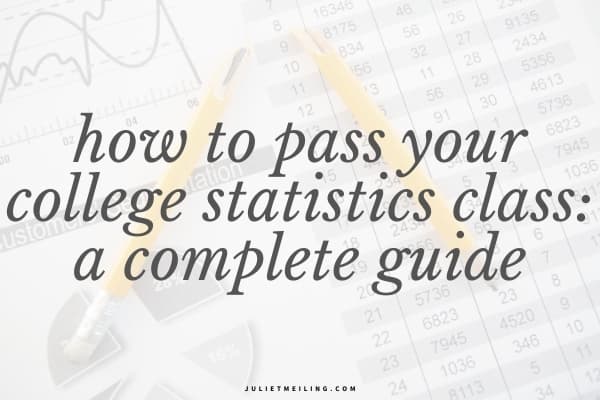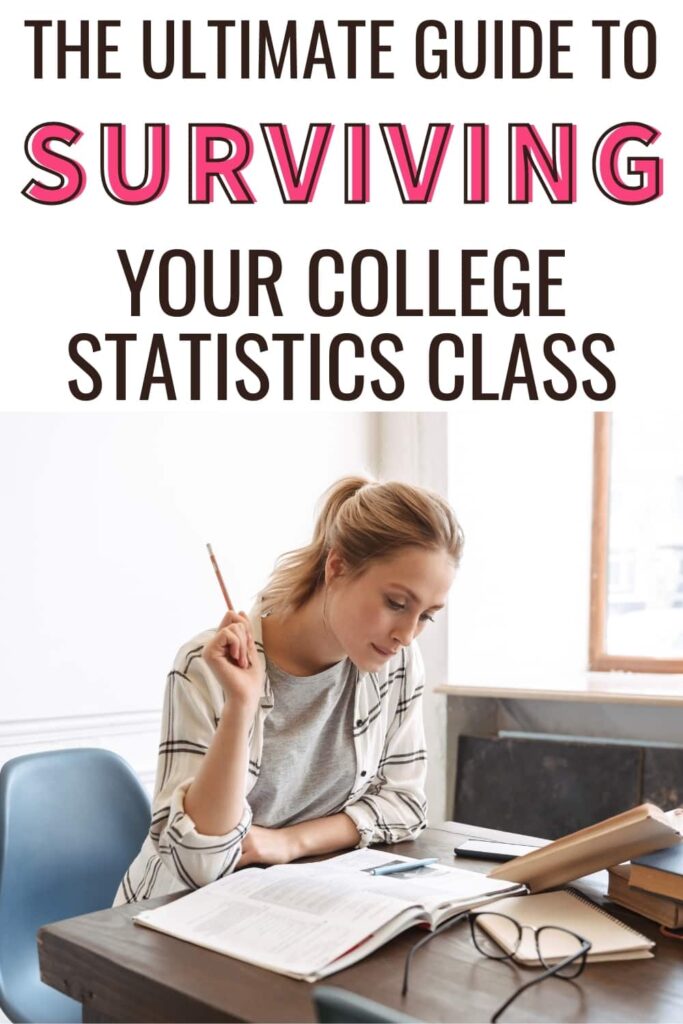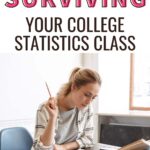How To Pass Your College Statistics Class: A Complete Guide
Learn how to survive and pass your college-level elementary statistics class.
For many college students, college is the first time you will encounter statistics. And because of this, it may be one of the more challenging classes you’ll take as an undergraduate student.
In this guide to passing your college statistics class, I am going to walk you through everything you need to know about taking statistics in college.
From the concepts you can expect to learn in class, study tips and tricks, and how to get help for statistics, I’m here to guide you through it all.
As a college elementary statistics tutor and graduate student in a Master of Science in Applied Statistics program, I feel like I know a thing or two about passing, and even acing, a statistics course.
So without further-ado, let’s get started.
- Learn how to survive and pass your college-level elementary statistics class.
- Should I take a statistics class?
- Should I take statistics online or in person?
- How do I prepare for a college statistics class?
- Is statistics hard in college?
- What do you learn in statistics class?
- How to get help for statistics
- What is the best way to study statistics?
- How can I pass a statistics exam without studying?
- Concluding thoughts on how to pass your college statistics course
- Thanks for reading about how to pass your introduction to statistics class in college.

*This post may contain affiliate links. Purchasing a product or service through an affiliate will earn me a small commission at no additional cost to you. Please read our Disclaimer Policy for more information about the use of affiliate links on this site.
Should I take a statistics class?
For most college majors, you are likely to be required to take a statistics class whether you like it or not.
For example, when I was an undergraduate, I majored in Psychology and was required to take an introduction to statistics course in order to take higher level psychology classes.
But if you have the choice to take statistics in college, I would highly recommend it since statistics is one of the most applicable math classes you can take. I mean think about it… we see statistics everywhere! You can also get assistance from services like thesisgeek.com if you ever start feeling like it’s getting too difficult.
From Facebook posts to newspapers, statistical data is used all the time to convince people to purchase things or to think or act in a certain way.
Taking a statistics class in college can help you think more critically about what you read on social media or see on TV and help you understand where the heck people get those numbers from.
Should I take statistics online or in person?
I would highly recommend taking your college statistics course in-person rather than online. Why?
For many college students, college is the first time they will encounter a full-fledged statistics course.
As a result, the material you learn in a stats class has a steep learning curve because there’s a lot of concepts and terminology that are very different than algebra or trigonometry, which are classes you’ve taken since at least high school.
Taking a statistics class in-person can help you learn and understand the concepts better because you get to interact more with your professor. And there are less distractions in an in-person class versus an online class.
When I worked as a statistics tutor during the Fall 2020 semester, I tutored a lot of students taking their intro to statistics class online and a lot of them mentioned having a difficult time learning the material on their own.
How do I prepare for a college statistics class?
Some colleges may require you to take prerequisite (pre-req) course, like college algebra, trigonometry, or precalculus, before taking your elementary or introduction to statistics course.
However, other colleges may let you take it without a prerequisite course.
Whether or not you are required to take a pre-req course, I’d highly recommend at least taking college algebra before taking your first statistics course.
In statistics, you’ll need to have:
- A basic understanding on how to manipulate formulas
- The ability to do basic calculations like adding, subtracting, multiplying, and dividing
- Confidence to work with numbers by hand and with a calculator.
Your college algebra course should help you gain those skills, so you can focus on the more challenging concepts of statistics like:
- Probability
- Confidence intervals
- Hypothesis testing
Is statistics hard in college?
Statistics is honestly like learning a new language.
It’s unlike any math class you have taken before because it involves a lot of reading comprehension with a side of math.
How I explain it to people: Statistics is 60% reading, 40% math.
Meaning, if you don’t understand what the problem is asking you to do or what to solve for, you’re going to have a very difficult time passing a statistics class in college.
In a statistics course, you’ll come across a lot of word problems, so you’ll need to be able to slow down, read, and extract the relevant information in order to solve the problem correctly.
Here’s an example:
A researcher is collecting data on how much television the average 18-year-old in the United States watches per week. They take a random survey of 30 18-year-olds and find that the mean average watch time is 15 hours with a standard deviation of 3 hours. Given that the population mean is 16 hours per week, is there enough evidence to conclude that the average amount of hours 18-year-olds watch television per week is actually less than the reported population mean?
Students who don’t read this problem carefully are likely to use the wrong formula, and therefore, get the problem wrong.
Is statistics harder than calculus?
Honestly, I think calculus is harder than statistics, but every student will have their own opinion on this.
Calculus is another beast in and of itself.
I consider it another “foreign language” of math if you have never even heard the words, for instance, “derivative” or “the Chain Rule,” in your life.
Is statistics easier than college algebra?
Most likely, you have taken some form of an algebra class since middle school or high school, so by college you should be pretty well adjusted to the rules and concepts of algebra.
With that being said, statistics will probably be harder than college algebra, but it really depends how your brain works and how easy it is for you to adjust to a new way of looking at math.
To be honest, I did not understand anything in my introduction to statistics class in college, yet I did surprisingly well it.
I only started grasping the concepts of statistics in my research methods in psychology class.
But then I went on the minor in statistics and even did a statistics research project and that’s when it truly clicked for me.
What do you learn in statistics class?
Statistics covers a wide variety of topics.
Some topics you may have heard of before, but here’s a list of what topics you can expect to learn in your first college statistics course:
- Population vs sample data
- Categorial vs numerical data
- Variable types
- Visualization of data (scatterplots, bar charts, steam and leaf plot, box and whiskers plot, etc.)
- Measures of central tendency (mean, median, and mode)
- Measures of dispersion (variance, standard deviation, and range)
- Probability
- Correlation and regression
- Confidence intervals
- The normal distribution
- Hypothesis testing
How to get help for statistics
If you currently are struggling in a statistics class, I would highly recommend getting help before it’s too late.
When it comes to getting help in your statistics class, you have several options:
- Get help from your professor
- Get a tutor on-campus or off-campus
- Use a service like Chegg Study
- Watch YouTube or Khan Academy videos
- Use any help features in your online homework tool (Connect Math, Aleks, etc.)
Getting help from your professor
The best resource for getting help in your stats class is your professor.
At the end of the day, they’re teaching you the concepts how they want you to learn it, so why not get help directly from the hand that feeds you?
You can ask questions in class, ask your professor your questions right after class, or go to their office hours for additional help.
I’m sure your professor would love to assist you in learning any statistical concept you are having difficulty with, but if you are finding your professor more confusing than helpful then consider getting a tutor.
Getting help from an on-campus or off-campus tutor
Going to your professor for help can be quite nerve wracking or may be challenging if you have a busy schedule that doesn’t fit your professor’s office hours.
Getting a tutor, either on-campus or off-campus, can be a great flexible option and allows you to get help from someone who’s already taken the class before or well-versed in the subject.
If you have to pick whether to go to an on-campus or an off-campus tutor, I would choose to go to an on-campus tutor first.
Why?
- You pay for on-campus tutoring services in your tuition and fees, so this is a “free” service you can take advantage of
- On-campus tutors are required have had made an A in the course, so they truly know what they’re doing
- Some on-campus tutors are even graduate students, like myself, so they are well-versed in the subject they are tutoring
- Tutors are students themselves, so they tend to be more empathetic and understanding about your struggles in statistics and in college
However, if on-campus tutoring is not an option, for whatever reason, you can find an off-campus tutor by asking your friends and family members, looking a bulletin boards posted around campus, or through a simple Google search.
You may also like: Failing College? 20 Things You Can Do To Overcome It
Using Chegg study
If you need additional help to your professor’s office hours or tutoring or you simply don’t have the time to do either one of the latter, then Chegg Study is a great option.
I personally have used Chegg Study in my graduate level Statistics Methods class and it was a total lifesaver!
I went from making a 70 on my first quiz to a 89 on my second quiz thanks to Chegg Study.
Using Chegg Study, you get access to on-demand textbook and homework step-by-step solutions to help you learn and understand difficult concepts on your own time. You can click here to check out Chegg Study for yourself. I absolutely love it and I bet you will too.
If your statistics textbook is making your head spin from all the mathematical jargon, I’d recommend trying out this textbook. It’s free to download and is by OpenStax, which is based at Rice University.
Watch videos on YouTube or Khan Academy
As hard as your professor tries to make statistical concepts make sense, it can still be challenging, especially if it really feels like statistics is a foreign language to you.
And sometimes, the teacher-student connection is just not there!
I’ve been there before, in my Statistics Methods class… my professor’s lectures always went over my head because she’s from an engineering background, so she speaks in very technical terms.
If you’re having a similar experience, sometimes it can help learning the concepts from another perspective.
On YouTube, I’d recommend watching videos by Brandon Foltz. He explains basic statistics concepts so well and he takes you step-by-step through easy to understand examples.
I’ve also heard great things about ZedStatistics on YouTube from another graduate student in my master’s program.
Khan Academy also has an entire library of videos about statistics and probability that you can access for free anytime you’d like.
Use the help features embedded in your online homework tool
Most likely, your college statistics homework will be done using a third-party website like Aleks or ConnectMath.
Both websites have tools to help you learn how to solve the problem and step-by-step instructions for each problem you come across.
Using these tools can help you touch up on concepts you may have missed in class or did not fully understand, so I would highly recommend using them if you are stuck on a homework problem.
However, sometimes these programs’ help tools use a different method to solve a problem than your professor. This may end up confusing you more, so rather than be frustrated, go straight to the source for help–meaning your professor or the teaching assistant if your class has one.
What is the best way to study statistics?
Just like any math class you have taken, the best way to study for a statistics quiz or test is to do as many practice problems as possible.
Get comfortable reading and working problems with different scenarios and ways of phrasing the same concept.
Also, the more practice you do, the more confident you will become in your abilities to do the calculations by hand and in the calculator.
But beyond doing practice problems until you’re blue in there face, here are 8 tips and tricks to help you survive statistics.
1. Never miss class
This goes for any class honestly… but if you want to be successful in college, especially a math-based class, then you need to show up and participate at every class meeting.
Missing class can set you back in your ability to succeed and it can be hard to catch back up once you have fallen behind.
If you do need to a miss a class, for whatever reason, try to:
- Find a classmate at the beginning of the semester who you can trust to send you class notes
- Arrange a meeting with your professor, explain your situation, and see if they would be willing to give you an abridged version of the concept(s) you missed
- Be prepared to seek out tutoring
If your class is online and synchronous, you may be able to get away with missing a class or two, especially if the lecture videos are uploaded after class.
But at the end of the day, nothing is better than attending a lecture in real time with your professor and classmates.
2. If your class is online, treat it like an in-person class
Going off of the previous tip, if your class is a synchronous online class, meaning you have a scheduled online meeting time with your professor and classmates, treat it like an in-person class.
This means:
- Don’t play on your phone or surf the internet while the lecture is in session
- Don’t log into the lecture and then walk away to “fake” your attendance
- Print out any course materials, guided notes, etc. and follow along with your professor just like you would do in an in-person class
You may also like: College 101: Zoom Classroom Etiquette For College Students
3. Do as many practice problems as you can
I’m repeating this tip because it is so important!
Math and statistics classes are not the kind of class where you can simply listen, watch your professor solve problems, and then instantly understand what is going on.
Instead, these classes very much like playing sports or learning how to play an instrument.
Meaning, if you want to become better at it, you have to actively practice!
So practice as many problems as you can.
Practice homework problems, textbook problems, in-class problems, and any additional practice problems your professor provides you.
For example, the professor who advises my graduate teaching assistantship uploads and shares previous quiz questions in the form of additional practice problems.
Students who do not practice these problems miss out on a huge opportunity to get familiar with the types of questions that could be on a future test or quiz.
So if your professor uploads extra practice problems, go ahead and do them. You never know when the same or a similar problem could show up on a future test or quiz.
4. Get help as soon as you start struggling
With statistics being such a new type of math for many college students, it is easy to get tripped up on concepts and start falling behind in the course.
If you find yourself struggling to understand something, even if it is as simple as parameter vs statistic, get help and get your confusions straightened out ASAP.
Again, you have so many resources on-campus, and even off-campus, to get help in statistics. So use them to your advantage!
Whether you go to your professor for help, a tutor, watch some videos online, or use a service like Chegg Study, there are always ways to get help that will fit your schedule and comfort level.
A very handy resource I’ve recently found for learning statistics is Penn State’s STAT 500 online class. It’s a free resource that takes you through basic statistics concepts in “plain english.”
5. Slow down and carefully read every single problem
Statistics is unlike any other math class you have taken before.
Instead of being given something to solve like this:
10 = 2x + 5
Where you have to solve for X, you are instead expected to read, interpret, and solve word problems with a bunch of statistics jargon (I like to call them keywords) like population mean, sample standard deviation, and confidence level.
If you don’t slow down and read the problem, you could easy make a mistake or misinterpret the problem altogether.
And once you’ve misunderstood what a problem is asking you to do, there’s no way you’ll get a correct answer.
So when you are solving any problem in a statistics class:
- Slow down and read the entire problem and then read it again
- Use a pencil or pen and underline key phrases or words
- Write down the relevant information you need to solve the problem in the margin of your paper
- Show your work for each problem, step-by-step
By showing your work for each problem, especially on a quiz or a test, you do have the potential to earn partial credit even if you get the final answer wrong.
And some professors may even deduct points if you don’t show your work, so always, always always, show your work!
6. If you get the opportunity to use a “cheatsheet” on a test or quiz, practice working problems with it beforehand
At least at my university, a lot of statistics professors allow students to use one side of notebook paper or an index card to make a “cheatsheet” to use on a quiz or test.
Instead of writing your cheatsheet the day before, try to create it at least 2-3 days before the assessment and practice using it while working practice problems.
You may also like: 11 Strategies To Help Manage Test Anxiety In College
By practicing problems with your cheatsheet beforehand, you’ll get used to finding the information you need to solve the problems faster. As a result, this can help you feel less anxious and more confident during test or quiz time.
7. Learn how to do calculations by hand and in your calculator
One of the best ways to learn statistics is by doing hand calculations. Why?
Because you ACTUALLY learn how each number operates in the formula. And you can’t learn that passively punching buttons on your calculator.
For example, when I was taking my research methods in psychology and experimental design in psychology class as an undergrad, my professors would NOT allow us to use a scientific calculator at all.
We could only use a simple 4-function calculator.
And although it was torture at times, it really helped me learn the actual process of statistics and understand each formula on a deeper level. In other words, I wasn’t just “plugging and chugging” and hoping I got it right. I actually understood what I was doing.
However, as much as you need to know how to do hand calculations, it is also important to know how to use your calculator correctly.
Your calculator can certainly come in handy when you are running low on time on a quiz or test or as a tool to double check your answers.
And if you’re looking for a good calculator for college or your first statistics class, I’d highly recommend a TI-84. But at the end of the day, go with whatever your professor recommends you getting for the class.
8. Create a statistics notebook to serve as a reference guide
Statistics, like any math class, has a ton of different concepts and formulas you’ll need to keep track of. But it can be easy for all of this valuable information to get lost in your notes.
So I would recommend creating a special statistics notebook separate from your in-class notes.
In this notebook you can write down:
- Formulas
- Statistics vocabulary or terminology
- Statistics symbol guide (alpha, mu, p, p-hat, etc.)
- Problems you have solved with a step-by-step solution
- Instructions on how to use the different STAT functions on your calculator
This notebook is intended to be a reference guide for you, so if you end up having a cumulative final, you can easily refresh your memory without having to dig through months worth of lecture notes.
How can I pass a statistics exam without studying?
I always recommend studying for your exams, but if you need a way to pass without studying, then make sure you:
- Pay really good attention in class
- Attend every class lecture
- Work through the in-class problems with your professor, aka, don’t just watch and listen, actually put your pencil down on paper and work the problems with them
- Do all your assigned homework problems
- And honestly…have a natural talent at math
Truthfully, it’s going to be very challenging to pass a statistics exam without studying.
It’s simply not possible, in my experience, unless you’ve had experience with these types of problems before in high school or even middle school.
So rather than try to take the easy way out, study.
It’ll pay dividends later in the semester when you aren’t scrambling to find ways to earn extra credit or emailing your professor the day final grades are due begging for a grade bump from a D to a C.
Concluding thoughts on how to pass your college statistics course
Introduction to statistics or elementary statistics will most likely be a class unlike any other you have taken in college or in high school.
It’s a challenging course with a lot of concepts mixed with algebra and reading comprehension.
And unfortunately for some students, they will struggle to keep up with the rigor of a college-level stats class.
But, you can ease the anxiety and stress of taking statistics in college by using the tips and tricks mentioned in today’s blog post. I truly hope you found this blog post informative and actionable.
And if you have any additional questions about taking statistics in college, please do not hesitate to leave a comment down below.
As a graduate student doing a Master of Science in Applied Statistics, statistics is my jam and I pretty much live and breathe it 24/7. So please, don’t hesitate to contact me or comment down below if you have any questions.
Related posts to surviving statistics in college
- How To Survive A Long Class Lecture In College
- How To Stay Motivated In College: 15 Student Motivation Tips
- The Ultimate Survival Guide To Online College Classes
Save this blog post to read or refer back to later by clicking the Pinterest share button below this image.








